Prepare for another disruptive year, warns Databuild
While increased government spending on infrastructure development will help to stabilise the construction industry by bringing a host of opportunities in the form of new projects, several risk factors continue to undermine the sector’s recovery.
“The biggest concern for the industry is the ongoing Covid-19 pandemic,” says Databuild CEO Morag Evans. “With the threat of a third wave of infections looming, successful rollout of the vaccine is undoubtedly the most pressing issue, and failure to immunise the population quickly enough will jeopardise the implementation and completion of construction projects.
“Should a third Covid-19 wave occur in South Africa, any lockdown levels that restrict movement or lead to suspension of activity and site closures must be provided for in contracts and tenders,” she continues.
“Contractors who have not included clauses relevant to the pandemic in these documents are putting their businesses at risk, as Covid-19 is no longer an unforeseen event and cannot be treated as force majeure.”
“In the meantime, it is imperative that contractors adhere strictly to health and safety protocols at all times. Construction sites where rules are continuously flouted are at risk of becoming super-spreaders which could lead to enforced shutdowns.”
Supply chain shortages
On the positive side, recent reports from Statistics South Africa reveal that wholesale trade sales of construction and building materials have increased significantly over recent months, driven mainly by an increase in demand of steel, cement and bricks.
However, severely constrained supply chains continue to cause materials shortages and increased procurement and delivery costs. “This could further impair the completion of projects and contractors need to factor this into their timelines and budgets,” says Evans.
Business liquidations and unemployment
Another risk facing the industry is the rising levels of unemployment. According to Statistics South Africa, liquidations in the construction sector during November last year were at their highest levels in two years as many organisations faced loss of revenue.
“The resultant job losses among workers could lead to an increase in illegal site invasions by the construction mafia as the unemployed labour force becomes more desperate to secure work,” says Evans. “Whether government will take decisive steps to stop these invasions remains to be seen. This issue, along with late payments to contractors and corruption in public and private projects, existed before the outbreak of the pandemic and despite many promises made, nothing has changed.”
The unemployment situation is further exacerbated by declining levels of non-residential building activity, owing to an oversupply of office and retail space.
“With many people now working from home it is highly likely that the oversupply will persist, at least until the end of the year. Architects and builders need to come up with innovative ways to refurbish these buildings to accommodate new ways of working.”
Opportunity through digitalisation
But with every challenge comes opportunity and Evans is hopeful that the current crisis will accelerate digitalisation and automation of the construction industry, which for South Africa, and indeed the African continent, is long overdue.
“Besides the improved decision-making and process efficiencies that digitalisation brings, it also reduces the dependence on extensive physical contact on site. The sooner companies begin using artificial intelligence, drones, 3D printing and BIM, the better they will cope with the effects of the pandemic,” she points out.
“The disruption caused by the pandemic is far from over and construction companies face a tough uphill battle during 2021 unless they effectively mitigate the risks facing the sector,” Evans concludes. “But businesses that successfully harness lessons learned during 2020 will find themselves better equipped to navigate the risks and soon start building their way back to positive growth.”


